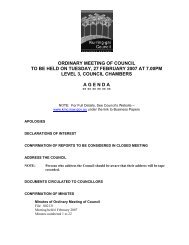Ku-ring-gai Heritage Conservation Areas North Inventory Sheet
Ku-ring-gai Heritage Conservation Areas North Inventory Sheet
Ku-ring-gai Heritage Conservation Areas North Inventory Sheet
Create successful ePaper yourself
Turn your PDF publications into a flip-book with our unique Google optimized e-Paper software.
<strong>Ku</strong>-<strong>ring</strong>-<strong>gai</strong><br />
<strong>Heritage</strong> <strong>Conservation</strong> <strong>Areas</strong> <strong>North</strong> <strong>Inventory</strong> <strong>Sheet</strong><br />
Historical<br />
Summary<br />
the eastern border extending to the borders of Robert Pymble’s grant.<br />
In 1876 the estate, known as The Big Island estate, was subdivided into large portions by a syndicate<br />
of politicians and businessmen, Burdett Smith, Burns and Withers. The boundaries of this first<br />
subdivision laid down the pattern of Wahroonga as it is now known, and a map showing the plan of<br />
roads in 1889 denotes the roads formed at that time and marks the boundaries of the portions. These<br />
roads were Boundary, Great Eastern (now Eastern), Burns, Billyard and Smith (now Bangalla)<br />
Roads.<br />
At the time of the subdivision of The Big Island estate, some lots were bought separately to the major<br />
holdings. One of these became known as ‘Noonan’s Paddock’ after its owner. Patrick Noonan<br />
occupied the lot now bounded by Stuart, Coonanbarra, Illoura and spanning what was later to be the<br />
railway station. At the time of the second survey for the railway line (1883) there was little<br />
development shown in the central Wahroonga area. Noonan’s block and an adjacent block to the<br />
north were the only ones occupied at that time.<br />
In 1878 the largest of the portions created by the 1876 subdivision was itself subdivided (DP 503).<br />
This was the Vanceville Estate, bordered by Great Eastern (now Eastern) Road, Burns Road, a line<br />
south of and parallel to Cleveland and with cross streets Hastings, Smith (later Bangalla), Gordon<br />
Lane (later Chilton), and Billyard Avenue. Forty-one blocks, varying in size between one and seven<br />
acres (0.4-2.8ha), were sold to orchardists and market gardeners.<br />
The road pattern within the area results from this early subdivision history of The Big Island and<br />
Vanceville estates, and Noonan’s block remained open space and later became Wahroonga Park.<br />
Post 1890<br />
When the railway line was built (completed 1890), the line ran through Noonan’s Paddock, and the<br />
station at Wahroonga was initially known (and shown on maps) as “Noonan’s Platform”. The Upper<br />
<strong>North</strong> Shore was no longer perceived as a rural area for orchardists and market gardeners, but as a<br />
healthy and desirable place to live. Between 1891 and 1897, the remaining portions of The Big Island<br />
were subdivided, with streets forming a regular grid pattern, with other estates being offered after a<br />
two-year period. The pattern of land release was as follows: Wahroonga Estate between Woonona<br />
and Coonanbarra 1891, 1893, 1895, 1897; Bundarra Estate (north of the HCA) 1892, 1893;<br />
Wahroonga Heights Estate from Burns to Boundary, north to Woonona and east to Eastern Road,<br />
and with another section spanning Cleveland in 1893, 1895, 1897. This estate was released in<br />
several sections, with the first spanning Cleveland Road as DP 2943.<br />
At the same time orcharding lots in the former Vanceville Estate were further subdivided for<br />
residential lots. A characteristic of most of the residential lots in the Wahroonga area was the size of<br />
the lots: they were large, one to three acres (0.4-1.2ha) in size and were designed for politicians,<br />
business and professional men. George Collingridge, a resident of Hornsby, prepared an 1897 map<br />
of Wahroonga to illustrate his magazine Progress: An Illustrated Journal and Magazine. Although<br />
lands through to Boundary Road were fully subdivided by 1897, and although there were individual<br />
large homes facing Grosvenor, Junction and Kintore Streets, the concentration of development in the<br />
early years of the twentieth century occurred south of Burns Road (within HCA 27). These first<br />
residences were described as palatial, planted with magnificent gardens.<br />
Other lots of The Big Island held by individuals were independently subdivided, such as The<br />
Wahroonga Station Estate with lots fronting Coonanbarra and Railway Avenue, subdivided in 1910,<br />
and Barnes Estate east of Illoura Avenue.<br />
HCA28 and HCA28A are both wholly within the Wahroonga Heights Estate subdivided 1893, 1895<br />
and 1897.<br />
Wahroonga had a strong Presbyterian presence, and many street names reflect Scottish origins<br />
(Burns, Braeside, Stuart, Lochville). The first Wahroonga complex of shops in Coonanbarra Road<br />
was established in 1895 (designed by John Sulman) and consisted of George Boyne’s Railway<br />
Stores and McKye’s Bakery. An amusement hall also opened in Coonanbarra Road in 1896. The<br />
hall was bought by the Presbyterian community in 1898 and became known as the Wahroonga<br />
Presbyterian Hall. The foundation of St Johns Presbyterian (now Uniting) Church was laid in 1929,<br />
and services began in 1930. The Gillespie family of Wahroonga and Warrawee were major<br />
benefactors of the Presbyterian Church, initially lending the purchase price of the hall, and remaining<br />
KU-RING-GAI HERITAGE CONSERVATION AREAS NORTH INVENTORY

















